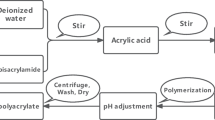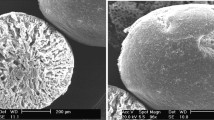Abstract
In this study, we investigated the remote interaction effect between industrial ion exchangers, namely Lewatit CNP LF (in H+ form) and AV-17-8 (in OH− form), in an interpolymer system called "Lewatit CNP LF:AV-17-8" (X:Y) with varying molar ratios (6:0, 5:1, 4:2, 3:3, 2:4, 1:5, and 0:6) immersed in a scandium sulfate solution. It should be mentioned that the interpolymer system represents a pair of cross-linked polymers with active functional groups that are in a common solution without direct contact. The mutual activation of the ion exchangers as the interpolymer system in the aqueous medium leads to conformational and electrochemical changes, resulting in their transition to a highly ionized state and enhanced sorption activity. To determine the conditions for maximum scandium ion sorption, we studied the influence of the initial conformational states of Lewatit CNP LF and AV-17-8 during their remote interaction. At a ratio close to 5:1, we observed significant changes in pH and electrical conductivity, which prompted us to thoroughly investigate the electrochemical properties of ratios between 5:1 and 6:0 using pH and electrical conductivity measurements. Our results showed that the interpolymer system "Lewatit CNP LF:AV-17-8" (5.6:0.4) exhibited a significant increase in sorption activity toward scandium ions. This research aims to develop highly efficient and selective universal sorbents activated by the remote interaction effect among functional polymers in an interpolymer system for the separation and extraction of a wide range of valuable metals (including scandium) and their compounds from industrial solutions.















Similar content being viewed by others
References
Balaram V (2019) Rare earth elements: a review of applications, occurrence, exploration, analysis, recycling, and environmental impact. Geosci Front 10(4):1285–1303. https://doi.org/10.1016/j.gsf.2018.12.005
Botelho Junior AB, Espinosa DCR, Vaughan J, Tenório JAS (2021) Recovery of scandium from various sources: a critical review of the state of the art and future prospects. Miner Eng 172:107148. https://doi.org/10.1016/j.mineng.2021.107148
ReportLinker. Scandium market—growth, trends, and forecast (2020–2025). GlobeNewswire News Room. https://www.globenewswire.com/news-release/2021/01/06/2153972/0/en/Scandium-Market-Growth-Trends-and-Forecast-2020-2025.html. Accessed 30 March 2023
Mondol S, Alam T, Banerjee R, Kumar S, Chattopadhyay K (2017) Development of a high temperature high strength Al alloy by addition of small amounts of Sc and Mg to 2219 alloy. Mater Sci Eng A 687:221–231. https://doi.org/10.1016/j.msea.2017.01.037
Schimbäck D, Mair P, Bärtl M, Palm F, Leichtfried G, Mayer S, Uggowitzer PJ, Pogatscher S (2022) Alloy design strategy for microstructural-tailored scandium-modified aluminum alloys for additive manufacturing. Scr Mater. https://doi.org/10.1016/j.scriptamat.2021.11427
Schmidtke K, Palm F, Hawkins A, Emmelmann C (2011) Process and mechanical properties: applicability of a scandium modified al-alloy for laser additive manufacturing. Phys Proc 12:369–374. https://doi.org/10.1016/j.phpro.2011.03.047
Savitskii EM, Burkhanov GS (1970) Melting and treatment of refractory metals and alloys. physical metallurgy of refractory metals and alloys. Springer, Boston, pp 235–283
Horovitz CT, Gschneidner KA, Melson GA, Youngblood DH, Schock HH (1975) Scandium: its occurrence, chemistry physics, metallurgy, biology, and technology. Academic Press, New York
Schulte PA, McKernan LT, Heidel DS et al (2013) Occupational safety and health, green chemistry, and sustainability: a review of areas of convergence. Environ Health. https://doi.org/10.1186/1476-069X-12-31
Dunn PJ (2012) The importance of Green Chemistry in Process Research and Development. Chem Soc Rev 41(4):1452. https://doi.org/10.1039/c1cs15041c
Jumadilov T, Yskak L, Imangazy A, Suberlyak O (2021) Ion exchange dynamics in cerium nitrate solution regulated by remotely activated industrial ion exchangers. Materials 14(13):3491. https://doi.org/10.3390/ma14133491
Hedwig S, Kraus M, Amrein M, Stiehm J, Constable EC, Lenz M (2022) Recovery of scandium from acidic waste solutions by means of polymer inclusion membranes. Hydrometallurgy. https://doi.org/10.1016/j.hydromet.2022.105916
Imangazy A, Jumadilov T, Khimersen K, Bayshibekov A (2023) Enhanced sorption of europium and scandium ions from nitrate solutions by remotely activated ion exchangers. Polymers 15(5):1194. https://doi.org/10.3390/polym15051194
Lozano A, Ayora C, Fernández-Martínez A (2020) Sorption of rare earth elements on Schwertmannite and their mobility in acid mine drainage treatments. Appl Geochem. https://doi.org/10.1016/j.apgeochem.2019.104499
Binnemans K, Jones PT, Blanpain B, Van Gerven T, Pontikes Y (2015) Towards zero-waste valorization of rare-earth-containing industrial process residues: a critical review. J Clean Prod 99:17–38. https://doi.org/10.1016/j.jclepro.2015.02.089
Jha MK, Kumari A, Panda R, Rajesh Kumar J, Yoo K, Lee JY (2016) Review on hydrometallurgical recovery of rare earth metals. Hydrometallurgy 165:2–26. https://doi.org/10.1016/j.hydromet.2016.01.035
Nastasović A, Marković B, Suručić L, Onjia A (2022) Methacrylate-based polymeric sorbents for recovery of metals from aqueous solutions. Metals 12(5):814. https://doi.org/10.3390/met12050814
Beaugeard V, Muller J, Graillot A, Ding X, Robin J, Monge S (2020) Acidic polymeric sorbents for the removal of metallic pollution in water: a review. React Funct Polym. https://doi.org/10.1016/j.reactfunctpolym.2020.104599
Czupryński P, Płotka M, Glamowski P, Żukowski W, Bajda T (2022) An assessment of an ion exchange resin system for the removal and recovery of Ni, Hg, and Cr from wet flue gas desulphurization wastewater—a pilot study. RSC Adv 12(9):5145–5156. https://doi.org/10.1039/d1ra09426b
Jumadilov T, Utesheva A, Grazulevicius J, Imangazy A (2023) Selective sorption of cerium ions from uranium-containing solutions by remotely activated Ion exchangers. Polymers 15(4):816. https://doi.org/10.3390/polym15040816
Jumadilov T, Malimbayeva Z, Khimersen K, Saparbekova I, Imangazy A, Suberlyak O (2021) Specific features of praseodymium extraction by intergel system based on polyacrylic acid and poly-4-vinyl pyridine hydrogels. Bull Kar Univ Chem Ser 103(3):53. https://doi.org/10.31489/2021Ch3/53-59
Jumadilov T, Yermukhambetova B, Panchenko S, Suleimenov I (2012) Long-distance electrochemical interactions and anomalous ion exchange phenomenon. AASRI Proc 3:553–558. https://doi.org/10.1016/j.aasri.2012.11.087
Mráček A (2010) The measurement of polymer swelling processes by an interferometric method and evaluation of diffusion coefficients. Int J Mol Sci 11(2):532–543. https://doi.org/10.3390/ijms11020532
Jumadilov T, Totkhuskyzy B, Imangazy A, Gražulevičius J (2023) Anomalous sorption of yttrium ions by the mutual activated hydrogels in the interpolymer system of poly (Methacrylic acid) and Poly(4-vinylpyridine). Chem Chem Technol 17(1):52. https://doi.org/10.23939/chcht17.01.052
Kabanov VA (1985) Practicum on high-molecular compounds. Chemistry, Moscow
Kurenkova VF (1990) Practicum on chemistry and physics of polymers. Chemistry, Moscow
Nesterov YV (2007) Ion exchangers and ion exchange. In: sorption technology for the extraction of uranium and other metals by in-situ leaching, Yunikor-Izdat, Moscow, 480 p.
Pearson RG (1963) Hard and soft acids and bases. J Am Chem Soc 85(22):3533–3539. https://doi.org/10.1021/ja00905a001
Alfarra A, Frackowiak E, Béguin F (2004) The HSAB concept as a means to interpret the adsorption of metal ions onto activated carbons. Appl Surf Sci 228(1–4):84–92. https://doi.org/10.1016/j.apsusc.2003.12.033
Matharu K, Mittal SK, Ashok Kumar SK, Sahoo SK (2015) Selectivity enhancement of Arsenazo(III) reagent towards heavier lanthanides using polyaminocarboxylic acids: a spectrophotometric study. Spectrochim Acta A Mol Biomol Spectrosc 145:165–175. https://doi.org/10.1016/j.saa.2015.02.054
Atkins PW (1993) The elements of physical chemistry, 3rd edn. Oxford University Press
Funding
This research was funded by the Science Committee of the Ministry of Science and Higher Education of the Republic of Kazakhstan (Grant No. BR18574042).
Author information
Authors and Affiliations
Corresponding author
Ethics declarations
Conflict of interest
The authors declare that they have no conflict of interest.
Additional information
Publisher's Note
Springer Nature remains neutral with regard to jurisdictional claims in published maps and institutional affiliations.
Rights and permissions
Springer Nature or its licensor (e.g. a society or other partner) holds exclusive rights to this article under a publishing agreement with the author(s) or other rightsholder(s); author self-archiving of the accepted manuscript version of this article is solely governed by the terms of such publishing agreement and applicable law.
About this article
Cite this article
Jumadilov, T.K., Imangazy, A.M., Khimersen, K. et al. Remote interaction effect of industrial ion exchangers on the electrochemical and sorption equilibrium in scandium sulfate solution. Polym. Bull. 81, 2023–2041 (2024). https://doi.org/10.1007/s00289-023-04800-x
Received:
Revised:
Accepted:
Published:
Issue Date:
DOI: https://doi.org/10.1007/s00289-023-04800-x




